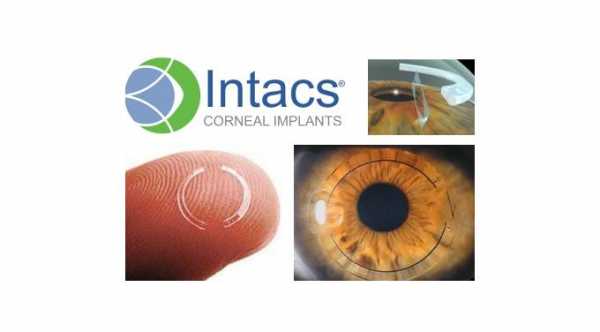
Intacs for Keratoconus
What is Keratoconus?
Keratoconus, also abbreviated as “KC”, is a progressive eye condition in which the normally round dome-shaped cornea bulges out into a cone with associated thinning of the cornea. The irregularity in the shape of the cornea causes visual distortion. In advance cases of keratoconus, there may be a significant sudden loss of vision.
What is Intacs?
Intacs is a US trademark name for Intrastromal corneal ring segment (ICRS), Intracorneal ring segments, or simply corneal rings/inserts. Intacs are thin semi-circular plastic rings that are inserted in the mid layer (stroma) of the cornea and are situated on the sides of the pupil.
These implants were originally used to treat mild cases of nearsightedness (myopia) and were later on approved by the Food and Drug Administration (FDA) for the treatment of keratoconus.
How is Intacs used for Keratoconus?
The purpose of Intacs is to flatten the portion of the cornea where it is implanted which consequently remodels the shape of the cornea. This remodeling addresses the corneal irregularities caused by keratoconus. In effect, improved vision and reinforcement of the cornea can be achieved.
Depending on the severity of the case, patients might still need additional treatment to provide better vision and stability of the condition.
Intacs Procedure
Intacs corneal ring insertion is a same day procedure. It is a minimally invasive eye surgery that takes about 15-20 minutes per eye. Depending on the case, 1 or 2 rings may be used on each eye. The size of the corneal ring will also depend on the treatment plan.
Anesthetic eye drops will be instilled on the eye.
A lid speculum will be used to keep the eye open and to avoid blinking.
A small incision will be made on the surface of the cornea. Initially, some instruments were used to mechanically cut the cornea. Surgeons now have the option to make the incision with Femtosecond laser.
The Intacs corneal ring will then be inserted into the stroma. The incision is left without suture but sometimes sutures are needed
- Bandage contact lens will be applied and medicated eye drops will be instilled on the eye.
The surgeon may or may not put an eye patch after the surgery.
These implants can be changed and removed as required.
After the Intacs Surgery
Improvement in vision may be noticed the day after the surgery, but fluctuations are to be expected as the cornea adjusts and heals.
Eye drops will be prescribed for about 1-2 weeks to avoid infection and inflammation.
The use of eye shield to avoid subconscious rubbing of the eye when sleeping will be advised for the first 2 weeks after the surgery.
Continuous follow-up is required to monitor corneal changes as well as to decide whether additional treatment will be required or be beneficial for the patient.
Possible Complications of Intacs Surgery
Complications of intacs corneal ring are not so common since no corneal tissue is removed and the implantation is reversible. But some patients may complain of pain, discomfort, glares and sensitivity to light—these are expected especially on the first few days after the surgery and will gradually improve.
Other uncommon complications may arise from the insertion of the implant as well as post-operative infection, delayed corneal healing , extrusion and anterior chamber perforation.


